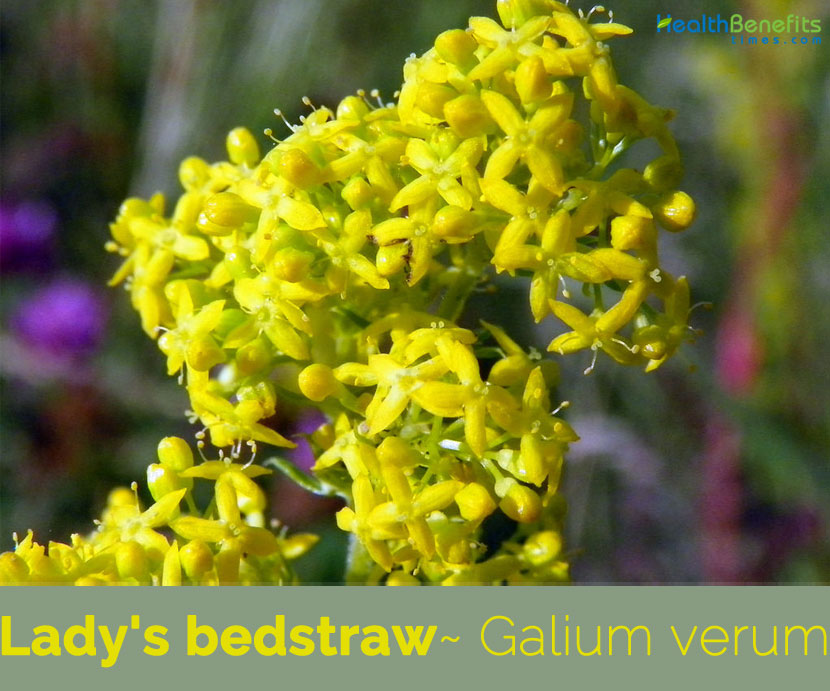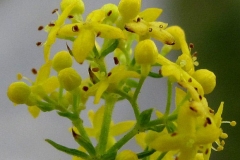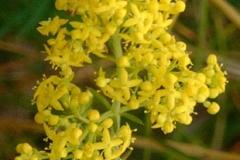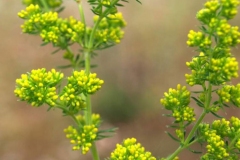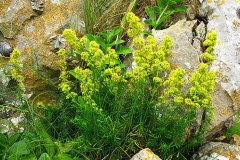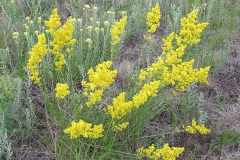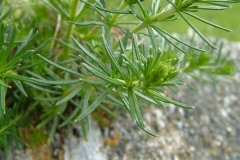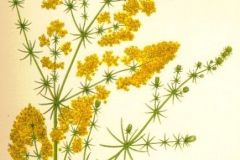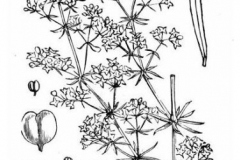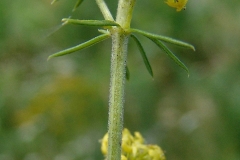The name Cheese Rennet is so called as the plant has the capability to curdle milk and that in the 16th century it was used to turn milk into cheese. Galium, the genus name, comes from the Greek noun gala, meaning milk. It is a reference to the former use of flowers of various Galium species to help make milk coagulate during the process of making cheese. The specific epithet verum means true to type or standard. Yellow dye obtained from flowering stems has been used as a food coloring for cheese or butter. Red dye can be made from the roots. Roasted seed has been used as a coffee substitute. Plant material was reportedly used in the crib of Jesus Christ.
Lady’s Bedstraw Facts
| Lady's bedstraw Quick Facts | |
|---|---|
| Name: | Lady's bedstraw |
| Scientific Name: | Galium verum |
| Origin | Europe, North Africa, and temperate Asia from Palestine and Israel, Lebanon and Turkey to Japan and Kamchatka |
| Colors | Black |
| Shapes | Glossy, glabrous, 0.2 in. (5 mm) wide, black schizocarps often hairy |
| Taste | Astringent, acidulous and bitterish taste |
| Health benefits | Good for Skin health, Throat health, Maintain Kidney Health, cures rashes and skin allergies and Cure urinary issues |
| Name | Lady’s Bedstraw |
|---|---|
| Scientific Name | Galium verum |
| Native | Most of Europe, North Africa, and temperate Asia from Palestine and Israel, Lebanon and Turkey to Japan and Kamchatka. It is naturalized in Tasmania, New Zealand, Canada, and the northern half of the United States |
| Common Names | Lady’s Bedstraw, Yellow Spring bedstraw, Wirtgen’s bedstraw, Clivers, Goosegrass, Yellow Bedstraw, Maid’s Hair, Cheese Rennet, Hedge Bedstraw |
| Name in Other Languages | Albanian: Ngjitëse, ngjitësja e vërtetë Arabic: Juisa Khadhra, Kish El-Furash, English: lady’s bedstraw, yellow bedstraw, jawaysiat khudira (جويسئة خضراء), qash alfarash (قش الفراش) Azerbaijani: Əsl qatıqotu Basque: Ziabelar hori Bulgarian: еньовче, dragaĭka (драгайка), istinsko en’ovche (истинско еньовче), obiknoveno en’ovche (обикновено еньовче), sŭshtinsko en’ovche (същинско еньовче) Catalan: Espunyidella groga, Espunyidella, Espunyidera, Gali, Herba de la mel, Herba formatgera, Quallallet, espunyidella vera, herba de talls, herba mosquera Chinese: Péng zǐ cài (蓬子菜) Croatian: Ivanjsko cvijeće, prava broćika Czech: Svízel syřišťový Danish: Gul snerre Dutch: Geel walstro, Geel walstro subsp. Maritimum, Geel walstro subsp. Verum, Echt walstro English: Yellow Spring bedstraw, Lady’s bedstraw, Yellow bedstraw, Estonian: Hobumadar Finnish: Keltamatara, helokeltamatara French: Gaillet jaune, Gaillet vrai, Caille-lait jaune, bonsang, caille vrai, caille-lait officinal, caillet-lait jaune, fleur de la Saint-Jean, gaille vrai, herbe à cailler, herbe à la vierge, petit muguet Galician: Agana, Callaleite, Herba coalleira, Herba da agana, Herba do agano, Herba do rodicio, Herba dos aganos, Preseira, Presoiro, Rodesno Georgian: Mindvrisnemsa (მინდვრისნემსა) German: Echtes Labkraut, Gelbes Labkraut, Gelbes Waldstroh, Liebfrauenbettstroh, Liebkraut Hebrew: Devekah amittit, דְּבֵקָה אֲמִתִּית Hungarian: Tejoltó galaj Icelandic: Gulmaðra Irish: Boladh cnis Italian: Caglio vero, Erba zolfina, Caglio zolfino, presuola Japanese: Kawaramatsuba (カワラマツバ) Korean: Sol na mul (솔나물) Latvian: Istā madara Lithuanian: Tikrasis lipikas Macedonian: Ivansko cveḱe (Иванско цвеќе) Malayalam: Gāliyaṁ veraṁ (ഗാലിയം വെരം) Northern Sami: Fiskesmáđir Norwegian: Jomfru Mariae seng-foor, Mari-fægre, Guul-mour, Mour, Opskred-fægre, Gulmaure Occitan: Calha lach, Cirouso, Erbo de la ciro Persian: شیرپنیر Polish: Przytulia właściwa Portuguese: Gálio-amarelo, gálio-verdadeiro, coalha-leite, erva-coalheira, erva-do-coalho, galião Romanian: Sînziene galbene Russian: Podmarennik zholtyy (Подмаренник жёлтый), Podmarennik nastoyashchiy (Подмаренник настоящий) Serbian: Ivanjsko cveće (Ивањско цвеће), ivanjska broćika (ивањска броћика) Shambala: Ivanjsko cvijeće Slovak: lipkavec pravý, lipkavec syridlový, lipkavec syrišťový pravý Slovene: Prava lakota Spanish: Prava Lakota, agana, cuaja leche, cuajaleche, cuajaleches, cuaxaleche, galio de flor amarilla, galio, hierba cuajadera, hierba sanjuanera, presera, quaxa leche, yerba cuajadera, yerba de la grama, yerba de la grana, yerba sanjuaner, cera virgin, galio Amarillo, lagrimera Swedish: Gulmåra, Keltamatara, Jungfru Marie sänghalm, Honinggräs Turkish: Sarı yoğurt out, boyalık Ukrainian: Pidmarennyk spravzhniy (Підмаренник справжній) Upper Sorbian: Žołty sydrik Welsh: Briwydd felen |
| Plant Growth Habit | Robust, frost tolerant wild, herbaceous perennial plant |
| Growing Climates | Waste ground, roadsides, near sea, lawns, roadsides, open, disturbed areas, sandy and dry meadows, juniper groves, rocky outcrops, banks, dunes and seashores |
| Soil | Requires a deep, light and rich loamy soil |
| Plant Size | 60–120 centimeters (24–47 in) long |
| Stem | Erect, 4-sided with rounded angles, densely puberulent, villosulous, or hirtellous to rarely glabrous and smooth, covered in short hairs to varying degrees, rarely hairless |
| Leaf | 1–3 cm (0.39–1.18 in) long and 2 millimetres (0.079 in) broad, shiny dark green, hairy underneath, borne in whorls of 8–12 |
| Flowering season | July to August |
| Flower | Yellow in color, and produced in dense clusters, 2–3 mm (0.079–0.118 in) in diameter, pointed, longer than they are wide, with 3 to 5 petals and 4 yellow stamens |
| Fruit Shape & Size | Glossy, glabrous, 0.2 in. (5 mm) wide, black schizocarps often hairy |
| Fruit Color | Black |
| Propagation | By seed and by rhizomes |
| Taste | Astringent, acidulous and bitterish taste |
| Plant Parts Used | Leaves, flowers and whole plant |
| Available Forms | Infusion, fresh juice, ointment |
| Season | August to September |
| Health Benefits |
|
| Precautions |
|
Plant Description
Lady’s bedstraw is a robust, frost tolerant wild, herbaceous perennial plant that normally grows about 60–120 centimeters (24–47 in) tall. The plant is found growing in waste ground, roadsides, near sea, lawns, roadsides, open, disturbed areas, sandy and dry meadows, juniper groves, rocky outcrops, banks, dunes and seashores. The plant requires a deep, light and rich loamy soil. Stem is erect, 4-sided with rounded angles, densely puberulent, villosulous, or hirtellous to rarely glabrous and smooth, covered in short hairs to varying degrees and rarely hairless.
Leaves
The leaves are whorled, very narrow, up to 1–3 cm (0.39–1.18 in) long and 2 millimeters (0.079 in) broad, shiny dark green, hairy underneath, borne in whorls of 8–12.
Flower
Flowers are yellow in color, and produced in dense clusters, 2–3 mm (0.079–0.118 in) in diameter, pointed, longer than they are wide, with 3 to 5 petals and 4 yellow stamens. Flowering normally takes place in between July to August.
Fruit
Fertile flowers give way to glossy, glabrous, 0.2 in. (5 mm) wide, black schizocarps often hairy and bristly clinging to clothes and animal hair. The fruits ripen in August-September. Each fruit contains a single brown seed.
Health benefits of Lady’s Bedstraw
Lady’s Bedstraw is an herb that was, and in some cases still is, widely used in not only medicinal way but also as a part of everyday lives. It is used as an incredible red dye, cheese and milk flavoring and followed by a variety of beliefs and folk stories; Lady’s Bedstraw has been used for thousands of years. Medicinally, it is used for the skin, throat and all the systems of liquids in the body. It doesn’t have a wide range of benefits but what it does, it does deeply and strongly. Listed below are some of the popular health benefits of Lady’s bedstraw
1. Natural Diuretic
Lady’s Bedstraw is considered a successful diuretic. Tea prepared from this herb helps detoxify the liver, kidneys, spleen and pancreas. It is advisable that people suffering from a lymphatic system disorder should drink this herbal tea every day. It is used as a remedy in gravel, stone, cystitis or urinary disorders. Its diuretic properties help flush out the toxins from your body and along with them, the uric acid which the main cause of pain in gout and arthritis. Lady’s Bedstraw is widely used in folk medicine for treating swollen ankles.
2. Skin health
Lady’s Bedstraw is related with the treatment of many skin-related conditions. The herb helps to solve complaints of slow-healing wounds. When applied topically as a poultice on cuts, skin infections, ringworm, eczema, ulcers, scabies, boils, rashes, psoriasis, allergies, and slow-healing wounds, it calms the skin and reduces inflammation, helping the skin to heal. It also helps in reducing bleeding. Additionally, this tea is also a wonderful face wash and helps to firm up the facial skin, as well as helping with acne and blackheads.
3. Throat health
Lady’s bedstraw is helpful for various problems regarding the throat and the organs close to it. With this intention, you can use it as a tea or as a gargle. It helps with different cancers: skin, tongue and larynx. Thyroid issues, goiter, and vocal cords inflammations also benefit from this herb.
4. Helps Maintain Kidney Health
One of the prime uses of this herb includes improving as well as maintaining the health of kidneys. It helps in dissolving kidney stones and hence at the same time tends to be effective in cleaning it of any toxins.
5. Maintain the health of skin
Extract of this herb when applied topically has been known to be effective in treating issue such as rashes and skin allergies.
6. Cure urinary issues
The herb has been known to be effective in treating disease related to urinary tract. Extract from this herb has been known to kill bacteria in the intestine and can at the same time remove issues such as intestinal ulcers.
Traditional uses and benefits of Lady’s bedstraw
- Lady’s bedstraw has a long history of use as an herbal medicine, though it is little used in modern medicine.
- Its main application is as a diuretic and as a treatment for skin complaints.
- Leaves, stems and flowering shoots are antispasmodic, astringent, diuretic, foot care, lithontripic and vulnerary.
- Plant is used as a remedy in gravel, stone or urinary disorders and is believed to be a remedy for epilepsy.
- Powder made from the fresh plant is used to soothe reddened skin and reduce inflammation whilst the plant is also used as a poultice on cuts, skin infections, slow-healing wounds etc.
- It was applied externally in poultice, used for indolent tumors, strumous swellings and tumors of the breast.
- Internally it was used in decoction sweetened with honey, for urinary stone complaints, scurvy, dropsy, hysterics, epilepsy and gout.
- It was also used in the bleeding of the nose and stomach problems, and it was said that it peculiarly beneficial in scorbutic, scrofulous, and dropsical complaints.
- Cut and dried aerial parts have been used for exogenous treatment of psoriasis or delayed wound healing or as a tea for the cure of pyelitis or cystitis.
- The plant was also used in traditional medicine as an anticancer medicine applied in most cases as a decoction.
- Tea made out of the leaves is known to be effective in curing urinary issues.
- Lady’s bedstraw is used for treating cancer, epilepsy, hysteria, spasms, and tumors, loss of appetite & chest & lung ailments.
- It is also used to increase urine output for relieving water retention, especially swollen ankles.
- It is advisable that people suffering from a lymphatic system disorder should drink this herbal tea every day.
- Tea is also useful for treating dropsy, anemia & suture in the side.
- Yellow bedstraw can be used for treating conditions, such as hysteria, nervous disorders, St. Vitus dance or chorea, suppressed urine, stones & gravels in the bladder.
- People suffering from goiter may find this herb beneficial if they gargle the tea throughout the day.
- You can make pillows of bedstraw to combat sleeplessness.
- Tea prepared with the herb is effective in cleansing the kidneys, liver, pancreas as well as the spleen of toxic materials.
- Its tea is also used topically to heal skin complaints, boils, wounds as well as blackheads.
- This tea is also a wonderful face wash and helps to firm up the facial skin.
- Yellow bedstraw was extremely valued as a medication for women’s problems, particularly in treating uterus disorders.
- The herb was also laid in the beds of women during childbirth as it was known to alleviate the difficulties endured during delivery.
Culinary Uses
- Leaves can be consumed raw or cooked.
- Yellow dye from the flowering stems is used as a food coloring.
- Roasted seeds are considered a good substitute for coffee.
- The seed is also said to be edible.
- The chopped up plant can be used as rennet to coagulate plant milks.
- The flowering tops are distilled in water to make a refreshing acid beverage.
Other Facts
- Red dye is obtained from the root.
- It is rather tricky to utilize.
- Yellow dye is obtained from the flowering tops.
- Dye is obtained from the foliage when it is boiled with alum.
- Dried plant has the scent of newly mown hay; it was formerly used as a strewing herb and for stuffing mattresses etc.
- It is said to keep fleas away.
- A sprig in a shoe is said to prevent blisters.
- The stem and leaves of this Galium yield good yellow dye, which has been used to great extent in Ireland.
- In Denmark, the plant (known locally as gul snerre) is traditionally used to infuse spirits, making the uniquely Danish drink bjæsk.
- In medieval Europe, the dried plants were used to stuff mattresses.
- The coumarin scent of the plants acts as a flea repellant.
References:
http://www.theplantlist.org/tpl1.1/record/kew-87863
https://npgsweb.ars-grin.gov/gringlobal/taxon/taxonomydetail?id=70981
https://pfaf.org/User/Plant.aspx?LatinName=Galium+verum
http://www.floracatalana.net/galium-verum-l-subsp-verum
https://botanical.com/botanical/mgmh/b/bedlad25.html
https://plants.usda.gov/core/profile?symbol=GAVE
https://www.itis.gov/servlet/SingleRpt/SingleRpt?search_topic=TSN&search_value=34936#null
https://en.wikipedia.org/wiki/Galium_verum
https://www.invasiveplantatlas.org/subject.html?sub=11551
http://biology.burke.washington.edu/herbarium/imagecollection/taxon.php?Taxon=Galium%20verum
https://www.researchgate.net/publication/324521615_GALIUM_VERUM-A_REVIEW
https://www.cabi.org/isc/datasheet/24776
https://www.wikidata.org/wiki/Q156854
http://www.narc.gov.jo/gringlobal/taxonomydetail.aspx?id=70981
https://gd.eppo.int/taxon/GALVE


